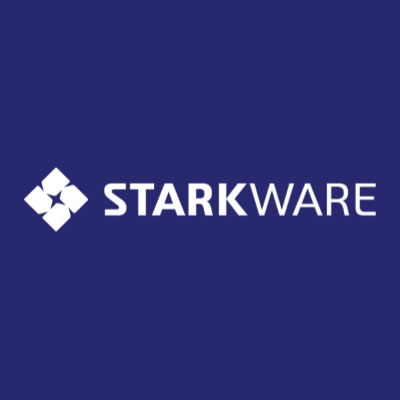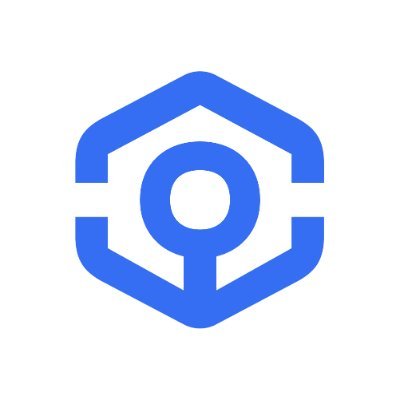ABCDE: Why We Invest in Bitlayer
Author: ABCDE
With the heated discussions on Bitcoin scaling, various second-layer solutions for Bitcoin have emerged over the past six months.
The ideal Bitcoin second layer should not only inherit Bitcoin's security features but also build a scalable and programmable on-chain financial infrastructure.
Bitlayer leads the Bitcoin second-layer solution based on BitVM, utilizing Layered Virtual Machine technology, zero-knowledge proofs (zkp), and optimistic verification (op) mechanisms to support various computations. Additionally, Bitlayer has established a dual-channel two-way locked asset bridge through OP-DLC and the BitVM bridge, achieving security equivalent to Bitcoin's first layer.
At the same time, the success of a chain is inseparable from ecosystem development. Bitlayer has currently reached ecological construction and cooperation with 80 projects, with an intended TVL exceeding 1 billion USD.
I. Design and Advantages of Bitlayer
The main technical innovation of Bitlayer lies in the adoption of the latest BitVM computing paradigm and the OP-DLC bridge.
Compared to other Bitcoin second-layer solutions, Bitlayer aims to address three core issues faced by second layers and proposes corresponding solutions:
- Trustless 2-Way Peg --- --- Combining OP-DLC with the BitVM bridge introduces an innovative model that transcends traditional multi-signature modes.
- Layer 1 Verification --- --- Inheriting Bitcoin's security through BitVM.
- Turing-Completeness --- --- Supporting multiple virtual machines, achieving a 100% Ethereum Virtual Machine (EVM) compatible environment.
Design Architecture
Optimistic Verification
Bitlayer adopts the same optimistic execution mechanism as Optimistic Rollup, combined with the MATT proposal (Merkelize All The Things) architecture. The system will rely on fraud proofs and challenge-response protocols, without modifying Bitcoin's consensus rules.
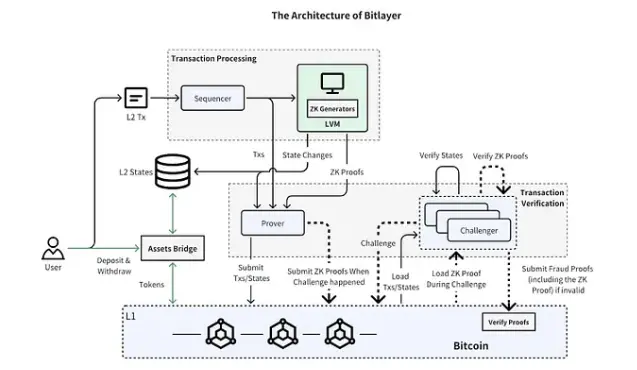
Source: Bitlayer Technical White Paper
We know that submitting a large program to a Taproot address requires significant off-chain computation and communication, but its on-chain footprint is very small. As long as both parties cooperate, they can execute arbitrarily complex, stateful off-chain computations without leaving any trace on-chain. Only in the case of disputes is on-chain execution required. If a participant proves the invalidity of a transaction, the transaction will be rolled back.
Bitlayer reduces data load and associated costs by performing off-chain computation and communication, then submitting the state and zero-knowledge proofs in a compressed format to a layer one blockchain, achieving second-layer scalability.
Building a Trustless Cross-Chain Bridge
The security of bridging assets has always been a key issue for second-layer solutions, with the core problem being the method of asset control. The most common industry approach is for second-layer platform operators to set up multi-signature accounts based on MPC-TSS (Multi-Party Computation and Threshold Signature Scheme) or Schnorr technology, into which users transfer their assets. This traditional method results in users completely losing control over their assets, while Bitlayer utilizes OP-DLC + BitVM technology, allowing users to retain partial control over their assets, my assets are my own.
Through the dual-channel two-way locked bridge, Bitlayer not only meets the first-layer users' need for autonomous control over BTC deposit and withdrawal operations but also ensures that native second-layer users can withdraw smoothly.
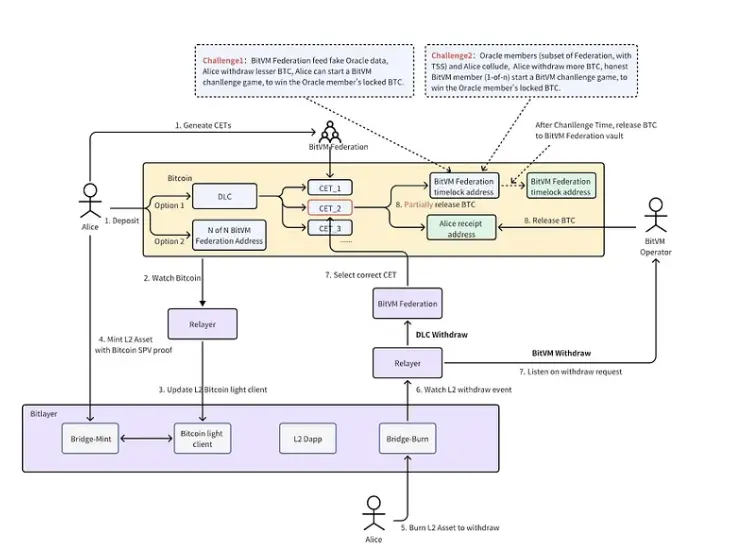
Layered Virtual Machine
To achieve financial functions such as collateralized lending, swaps, and complex contracts, Bitcoin's second layer needs a virtual machine (VM) with programmable execution capabilities.
Bitlayer introduces a Layered Virtual Machine (LVM), decoupling front-end execution of smart contracts from back-end zero-knowledge proof generation, supporting various smart contracts and zero-knowledge proof validators. With the help of Taproot, ZK-STARKs verification is simplified, ensuring security and computational flexibility.
By integrating support for EVM within the LVM framework, developers can seamlessly utilize existing EVM-based smart contracts while benefiting from the enhanced execution capabilities provided by the layered architecture.
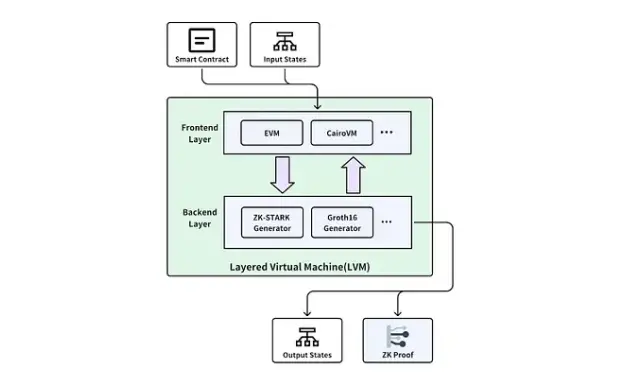
II. Flourishing Bitlayer Ecosystem
In terms of ecosystem development, leveraging strong cooperative resources, Bitlayer currently has 80 ecosystem partners, including infrastructure, stablecoins, wallets, and retrieval services. We believe that after the mainnet launch, the Bitlayer ecosystem will flourish.
Current ecosystem partners include: StarkWare, Hacken, AWS Cloud, Ankr, Polyhedra, Macaron, Trustin, Babylon, Particle Network, Meson, Nubit, BitSmiley, TokenPocket, Xverse, Flash Protocol, Umoja.xyz, RunesTerminal, Lamina, NFTGO, Giants Planet, Surf Protocol, Tria, Tonka Finance, Ordimint, and Caliber.
To incentivize development on Bitlayer, on March 29, Bitlayer officially announced a series of ecosystem incentive programs, with the first event, Ready Player One, offering a reward of 50 million USD in public chain tokens to ecosystem builders and project parties, encouraging projects such as Dex, Wallet, NFT Marketplace, Lending, LSD, Bridge, and Stablecoin to be built on Bitlayer.
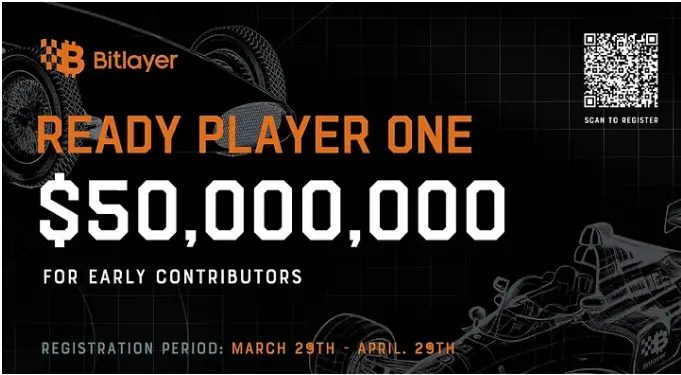
Currently, Bitlayer is also in deep cooperation talks with 180 potential partners and is preparing a series of incentive activities to attract user participation in Bitlayer community building, including launching Galxe and TaskOn loyalty points and ecosystem project ranking activities, as well as official NFTs.
III. Looking Ahead
Roadmap
With less than 10 days until the Bitcoin halving, Bitlayer mainnet V1 will launch soon.
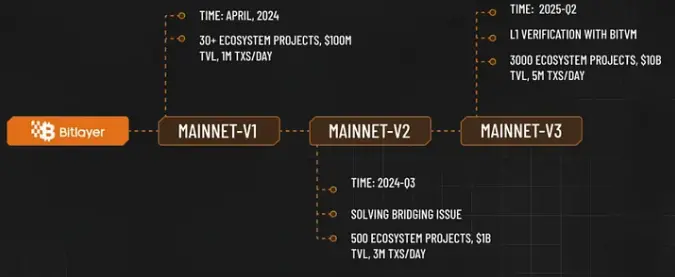
In the next 1-2 years, we firmly believe that we will see more Bitcoin-native innovations built and deployed on Bitlayer. Bitlayer can leverage the momentum of Bitcoin to become a bellwether for the development of the Bitcoin ecosystem.
Funding
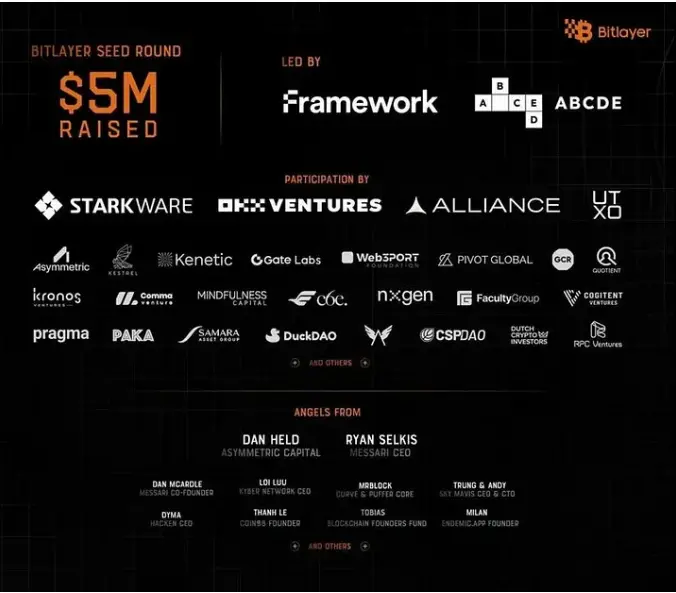
Recently, Bitlayer secured 5 million USD in funding, led by Framework Ventures and ABCDE Capital, with follow-on investments from StarkWare, OKX Ventures, Alliance DAO, UTXO Management, Ametry Capital, Kenetic Capital, Kestrel, Global Coin Research, Pivot Global, and Web3Port.
Notable angel investors include Messari CEO Ryan Selkis, Messari co-founder Dan McArdle, Asymmetry Capital founder Dan Held, Hacken CEO Dyma, Sky Mavis CEO Trung and CTO Andy, as well as Kyber Network founder Loi Luu, all of whom participated in this round of financing.
Bitlayer's seed round financing has received strong support from ecosystem partners, including Hacken, AWS Cloud, Ankr, Polyhedra, Babylon, Particle Network, Meson, Nubit, BitSmiley, TokenPocket, Xverse, Flash Protocol, Umoja.xyz, RunesTerminal, etc.







